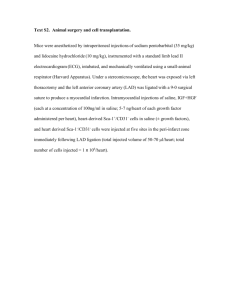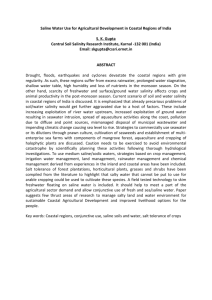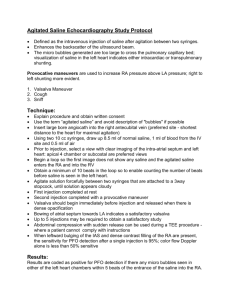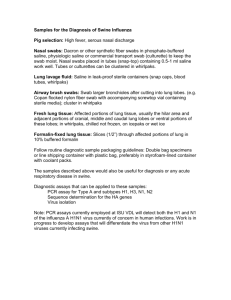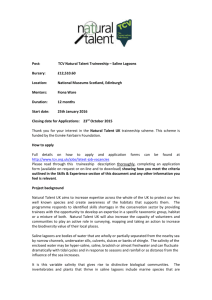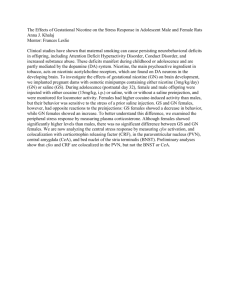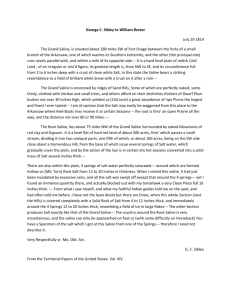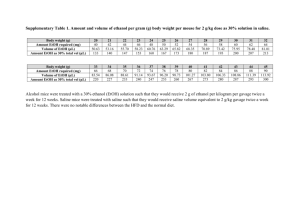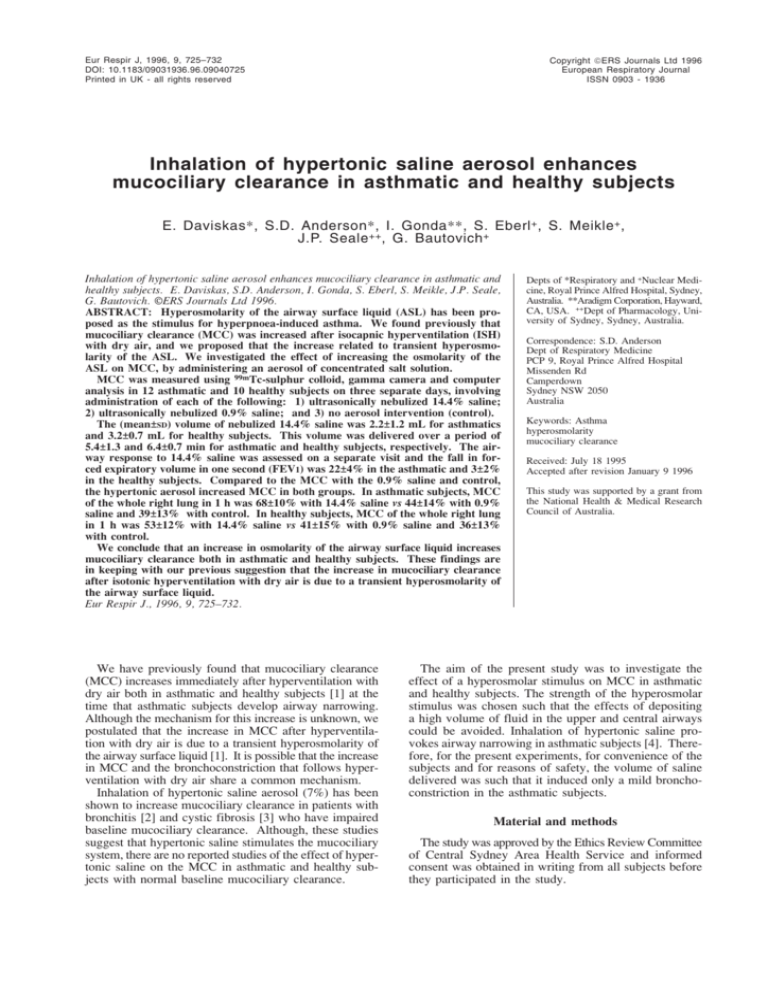
Copyright ERS Journals Ltd 1996
European Respiratory Journal
ISSN 0903 - 1936
Eur Respir J, 1996, 9, 725–732
DOI: 10.1183/09031936.96.09040725
Printed in UK - all rights reserved
Inhalation of hypertonic saline aerosol enhances
mucociliary clearance in asthmatic and healthy subjects
E. Daviskas*, S.D. Anderson*, I. Gonda**, S. Eberl + , S. Meikle + ,
J.P. Seale ++ , G. Bautovich +
Inhalation of hypertonic saline aerosol enhances mucociliary clearance in asthmatic and
healthy subjects. E. Daviskas, S.D. Anderson, I. Gonda, S. Eberl, S. Meikle, J.P. Seale,
G. Bautovich. ©ERS Journals Ltd 1996.
ABSTRACT: Hyperosmolarity of the airway surface liquid (ASL) has been proposed as the stimulus for hyperpnoea-induced asthma. We found previously that
mucociliary clearance (MCC) was increased after isocapnic hyperventilation (ISH)
with dry air, and we proposed that the increase related to transient hyperosmolarity of the ASL. We investigated the effect of increasing the osmolarity of the
ASL on MCC, by administering an aerosol of concentrated salt solution.
MCC was measured using 99mTc-sulphur colloid, gamma camera and computer
analysis in 12 asthmatic and 10 healthy subjects on three separate days, involving
administration of each of the following: 1) ultrasonically nebulized 14.4% saline;
2) ultrasonically nebulized 0.9% saline; and 3) no aerosol intervention (control).
The (mean±SD) volume of nebulized 14.4% saline was 2.2±1.2 mL for asthmatics
and 3.2±0.7 mL for healthy subjects. This volume was delivered over a period of
5.4±1.3 and 6.4±0.7 min for asthmatic and healthy subjects, respectively. The airway response to 14.4% saline was assessed on a separate visit and the fall in forced expiratory volume in one second (FEV1) was 22±4% in the asthmatic and 3±2%
in the healthy subjects. Compared to the MCC with the 0.9% saline and control,
the hypertonic aerosol increased MCC in both groups. In asthmatic subjects, MCC
of the whole right lung in 1 h was 68±10% with 14.4% saline vs 44±14% with 0.9%
saline and 39±13% with control. In healthy subjects, MCC of the whole right lung
in 1 h was 53±12% with 14.4% saline vs 41±15% with 0.9% saline and 36±13%
with control.
We conclude that an increase in osmolarity of the airway surface liquid increases
mucociliary clearance both in asthmatic and healthy subjects. These findings are
in keeping with our previous suggestion that the increase in mucociliary clearance
after isotonic hyperventilation with dry air is due to a transient hyperosmolarity of
the airway surface liquid.
Eur Respir J., 1996, 9, 725–732.
We have previously found that mucociliary clearance
(MCC) increases immediately after hyperventilation with
dry air both in asthmatic and healthy subjects [1] at the
time that asthmatic subjects develop airway narrowing.
Although the mechanism for this increase is unknown, we
postulated that the increase in MCC after hyperventilation with dry air is due to a transient hyperosmolarity of
the airway surface liquid [1]. It is possible that the increase
in MCC and the bronchoconstriction that follows hyperventilation with dry air share a common mechanism.
Inhalation of hypertonic saline aerosol (7%) has been
shown to increase mucociliary clearance in patients with
bronchitis [2] and cystic fibrosis [3] who have impaired
baseline mucociliary clearance. Although, these studies
suggest that hypertonic saline stimulates the mucociliary
system, there are no reported studies of the effect of hypertonic saline on the MCC in asthmatic and healthy subjects with normal baseline mucociliary clearance.
Depts of *Respiratory and +Nuclear Medicine, Royal Prince Alfred Hospital, Sydney,
Australia. **Aradigm Corporation, Hayward,
CA, USA. ++Dept of Pharmacology, University of Sydney, Sydney, Australia.
Correspondence: S.D. Anderson
Dept of Respiratory Medicine
PCP 9, Royal Prince Alfred Hospital
Missenden Rd
Camperdown
Sydney NSW 2050
Australia
Keywords: Asthma
hyperosmolarity
mucociliary clearance
Received: July 18 1995
Accepted after revision January 9 1996
This study was supported by a grant from
the National Health & Medical Research
Council of Australia.
The aim of the present study was to investigate the
effect of a hyperosmolar stimulus on MCC in asthmatic
and healthy subjects. The strength of the hyperosmolar
stimulus was chosen such that the effects of depositing
a high volume of fluid in the upper and central airways
could be avoided. Inhalation of hypertonic saline provokes airway narrowing in asthmatic subjects [4]. Therefore, for the present experiments, for convenience of the
subjects and for reasons of safety, the volume of saline
delivered was such that it induced only a mild bronchoconstriction in the asthmatic subjects.
Material and methods
The study was approved by the Ethics Review Committee
of Central Sydney Area Health Service and informed
consent was obtained in writing from all subjects before
they participated in the study.
E . D AV I S K A S E T A L .
726
Subjects
Twelve asthmatic and 10 healthy volunteers took part
in the study. Their anthropometric data are presented in
table 1. The asthmatic subjects had stable asthma and
a resting forced expiratory volume in one second (FEV1)
>85% of predicted, except for one subject (No. 7) (table
1). Most of the asthmatics were receiving β-agonists as
needed with or without inhaled corticosteroids (either
beclomethasone or budesonide). None of the asthmatic
subjects was taking theophylline. All asthmatics withheld their medication for at least 8 h before beginning
the protocol each day. All subjects were asked not to
take any nonsteroidal anti-inflammatory drugs or antihistamines for at least 48 h prior to each study day. None
of the subjects had a history of cigarette smoking and
none had a lower respiratory tract infection in the 6 weeks
prior to each study.
Visits 2–4: 1) spirometry; 2) radioaerosol inhalation; 3)
emission anterior/posterior images (static), 7 min after the
mid-inhalation time of the radioaerosol; 4) intervention
(up to 7.5 min); and 5) serial emission anterior/posterior
images (dynamic) for 45 min. On Visit 2, a transmission image was taken before the radioaerosol inhalation.
Interventions
Different interventions were used at each visit and the
order of the interventions was randomized between
subjects: 1) ultrasonically nebulized 14.4% saline; 2)
ultrasonically nebulized 0.9% saline; and 3) no aerosol
intervention (control). On the control study day, nasal
resting breathing occurred instead of an intervention.
The method of delivering the 14.4 and 0.9% saline was
identical.
Study design
Measurement of lung function
The study involved four visits, which were at least 48 h
apart. The procedure on each visit was as follows.
Visit 1: spirometry before and after hypertonic saline.
Spirometry, using a hot wire anemometer (Minato, AS500, Osaka, Japan), was measured before and after inhalation of hypertonic saline, on the first visit. All subjects
Table 1. – Anthropometric data, baseline FEV1, maximum fall of FEV1 in response to inhaled 14.4% saline aerosol
in the specified time, for asthmatic and healthy subjects
Sub.
No.
Sex
Asthmatic subjects
1
F
2
M
3
M
4
M
5
F
6
M
7
M
8
M
9
F
10
M
11
F
12
M
Mean
±SD
Healthy subjects
13
M
14
F
15
F
16
F
17
M
18
M
19
F
20
F
21
M
22
F
Mean
±SD
FEV1 FEV1/FVC Max
% pred
%
∆FEV1 %
Nebulized Delivery
volume
time
mL
min
Total
Salt
mg
Age
yrs
Height
cm
20
23
18
22
21
19
21
36
18
18
19
21
21
±5
166
182
188
175
162
179
171
180
170
186
166
184
176
±9
100
91
100
106
115
97
82
106
109
101
100
86
99
±9
91
79
79
90
82
80
77
73
80
81
88
82
82
±5
19
24
18
23
21
25
29
16
15
25
24
23
22
4
0.69
3.19
3.4
0.98
1.02
0.79
0.44
2.93
2.33
1.19
0.47
0.54
1.5
1.1
0.8
3.9
4.0
1.4
1.5
1.2
0.7
3.8
2.8
1.7
1.3
2.7
2.2
1.2
5.5
7.0
7.5
3.5
4.5
5.5
3.5
6.0
6.0
5.5
4.0
6.0
5.4
1.3
115
562
576
202
216
173
101
547
403
245
187
389
310
177
S
S, B
S
S, B
B, S
S
S
S, B
S
S, BUD
-
21
20
24
19
18
20
21
21
24
21
21
±2
178
161
167
163
175
182
165
171
163
162
169
±7
123
111
108
106
104
95
108
129
89
98
107
±12
90
84
82
91
87
82
88
92
74
90
86
±6
4
3
4
1
1
4
7
1
3
4
3
±2
NA
NA
NA
NA
NA
NA
NA
NA
NA
NA
3.2
2.9
2.3
2.4
3.0
3.2
2.9
4.1
4.8
3.0
3.2
±0.8
6.0
6.0
7.5
7.5
7.5
6.0
6.0
6.0
6.0
6.0
6.5
±0.7
461
418
331
346
432
461
418
590
346
432
423
±76
NA
NA
NA
NA
NA
NA
NA
NA
NA
NA
-
PD15
mL
Medication
Sub: subject; M: male; F: female; S: salbutamol; B: beclomethasone dipropionate; BUD: budesonide; FEV1: forced expiratory volume in one second; ∆FEV1: fall in FEV1 from baseline; FVC: forced vital capacity; PD15: dose of saline that provoked a 15% fall
in FEV1; NA: not applicable.
H Y P E RTO N I C S A L I N E A E R O S O L E N H A N C E S M U C O C I L I A RY C L E A R A N C E
had reproducible spirometry, which was within the normal range at rest. Predicted values for lung volumes were
taken from GOLDMAN and BECKLAKE [5] for adults. Predicted FEV1 was calculated as 79% of the predicted vital
capacity.
14.4% saline aerosol challenge
Our aim was to study the effect of hyperosmolarity on
MCC by delivering a volume of hypertonic saline that
could increase the osmolarity of the airway fluid to levels that bring on mild bronchoconstriction to asthmatic
subjects. While inhalation of 4.5% saline could increase
the osmolarity of the airway fluid and is suitable for provoking an attack of asthma, up to 15–20 mL of 4.5%,
containing 675–900 mg of salt, nebulized over a period
of 10–15 min, may be needed to induce a 15–20% fall in
FEV1 in subjects with mild asthma [4]. The exact volume of saline aerosol that deposits in the airways is not
known but it has been estimated that only 41% (range
22–58%) of the nebulized volume is inhaled [6], and of
this inhaled volume 15–35% will deposit on the first 10
generations [7]. Therefore, if 6–8 mL is inhaled and only
20% of this volume is deposited, this could double the
volume of the first 10 generations, which has been calculated to be less than 1 mL [8]. Therefore, the time involved
and the large volume of fluid that deposits on the airways
make the 4.5% saline challenge inappropriate for studies
of MCC. A concentration of 14.4% salt solution was chosen as the appropriate concentration that could alter the
osmolarity of the airway fluid following deposition of only
a small volume. A concentration of 14.4% saline was used
by RODWELL et al. [9] with a high output nebulizer, therefore its safety and subject acceptability had been tested.
The method for delivering the 14.4% saline was similar to the method described by SMITH and ANDERSON
[4]. The 14.4% saline aerosol was generated by a De
Vilbiss 99 ultrasonic nebulizer (De Vilbiss, Somerset, PA,
USA). The nebulizer was carefully set to deliver 0.1–
0.6 mL·min-1 of aerosol, depending on the sensitivity of
the asthmatic subject. Such an output can deliver 14.4–
72 mg NaCl·min-1. It was intended that the maximum
nebulized volume of aerosol would be approximately 3
mL containing 432 mg NaCl. Of this volume, if 41% is
inhaled and 20% is deposited, approximately 0.25 mL
containing 36 mg NaCl will deposit in the first 10 generations.
Subjects inhaled the aerosol at resting ventilation through
a two-way valve (No. 2700; Hans Rudolph, Kansas City,
MO, USA) connected to the nebulizer by Bennett tubing (Bennett Respiration Products, Los Angeles, CA,
USA) 45 cm in length and 2 cm internal diameter. The
unit was weighed with the tubing, but not the valve,
before the challenge and after the final dose, so the total
nebulized volume and the output of the nebulizer was
calculated for each subject.
On Visit 1, baseline spirometry was measured initially
and 10 min after arrival in the laboratory. Subjects then
inhaled the aerosol for 30 s, 1, 2 or 4 min depending on
the airway response. Spirometry was measured in duplicate at 1 min after each time interval of challenge. The
maximal response usually occurs within a minute after
each challenge. The challenge stopped if there was a 20%
727
fall in FEV1. Subjects who had a fall in FEV1 of 15% or
more were selected for the study. All asthmatic subjects
taking part in the MCC study had mild asthma and recovered spontaneously after the hyperosmolar saline challenge. The same protocol was followed for measuring the
airway responses in healthy subjects, with maximum inhalation of approximately 3 mL of 14.4% saline.
On the MCC study day, the delivery of the hyperosmolar aerosol was uninterrupted. The nebulized volume and the delivery time were kept the same for each
subject as on the assessment day (Visit 1). The volume
and the delivery time of the 0.9% saline was the same
as the hyperosmolar saline.
Measurement of mucociliary clearance
Inhalation of radioaerosol. Mucociliary clearance was
assessed using a radioaerosol technique. 99mTc-sulphur
colloid (Australian Radioisotopes, Sydney, Australia),
approximately 1 GBq, was diluted in 5 mL of isotonic
saline. The sulphur colloid particles are suitable for assessing mucociliary clearance as they are not transported
across the epithelia due to their size, insolubility and stability in the airway fluid. The clearance of insoluble particles is of two kinds: 1) fast, exclusively via the mucociliary
escalator; and 2) extremely slow, via macrophages. The
technetium is unleachably bound to sulphur colloid and
quality control procedures confirm this before use.
The radioaerosol was generated by an Inspiron Minineb jet nebulizer (C. R. Bard International Ltd) using
oxygen from a cylinder set to 6 L·min-1. The droplets
had a mass median aerodynamic diameter (MMAD) of
5.5 µm and a span of 1.8, measured by a laser diffraction technique (Malvern Mastersizer, Malvern Instruments
Ltd, Spring Lane South, Malvern, Worcestershire, UK).
The dilution air supplementing the flow to the mouthpiece was humidified to maintain the characteristics of
the droplets [10]. The radioaerosol was delivered with
a controlled breathing pattern in order to maximize deposition in the conducting airways. A closed breathing circuit was linked to a computer that allowed monitoring
and control of the breathing pattern, using a target volume and target inspiratory and expiratory times [11].
The target volume, set to 450 mL, was displayed on the
screen together with the target line oscillating at set rates,
aiming at a peak inspiratory flow rate of 60 L·min-1. The
inspiratory time was set higher than the expiratory time
and the subject tried to breath according to the set tidal
volume and flow rates. The patient inhaled the radioaerosol for approximately 3 min. This delivery time
was chosen so that the lung counts were about 2000
count·s-1 over the posterior thorax. Upon termination of
the delivery of radioaerosol, the subjects removed the
radioactivity from their oropharynx and the oesophagus
by rinsing and gargling with water and expectorating,
and by swallowing some bread and water.
Imaging. Lung images were obtained using a gamma
camera (Philips Diagnost Tomo; Hamburg, Germany) fitted with a low energy, all purpose, collimator and linked
to an on-line computer (DEC PDP11, Maynard, MA,
USA). The images were collected in a 64×64 matrix.
E . D AV I S K A S E T A L .
The lung fields of the subjects were delineated with
anterior and posterior transmission images [12] taken
with a flood source containing approximately 1.5 GBq
of 153Gd in water. One minute anterior and posterior
emission images (static) were collected for each subject
approximately 7 min after the inhalation of the radioaerosol. The purpose of this image was to define the
initial distribution of the radioaerosol deposition. Within
3 min post-intervention, the subject was placed in the
supine position and successive 20 s anterior and posterior emission images (dynamic) were collected for 45
min [13]. In order to align the lung fields between the
transmission, static and the dynamic images, images of
markers placed on premarked positions on the subject's
body were also collected at the end of each study. Care
was taken that all emission images were taken at the
same time after the mid-inhalation time of the radioaerosol
for the three study days.
Image and data analysis. All the images were decay
corrected to the mid-inhalation time. A geometric mean
image (GM) was obtained from the anterior and posterior images for the transmission, static and dynamic emission images [13]. The left lung was not analysed due to
possible interference from the activity in the stomach.
The right lung was divided into three regions of interest: central, intermediate and peripheral [14], in order to
estimate the initial deposition of the radioaerosol and for
regional analysis of the data. An estimate of the initial
deposition was obtained from the activity of the static
emission GM image by calculating the penetration index
(PI) as follows:
Statistical analysis
Analysis of variance with repeated measures (twofactor ANOVA) was performed to compare the effect of
hypertonic saline on clearance during and post-inhalation of saline between the two groups. Duncan's multiple range test was used to compare the clearance with
the three interventions. The same analysis was also done
for the clearance rate for each 10 min interval post-intervention. If the response of the interventions was different in the two groups then one-factor ANOVA was
performed for each group separately.
Comparison of the deposition of radioaerosol on the
three study days of both groups was performed using analysis of variance with repeated measures (two-factor
ANOVA).
Results
Inhalation of 14.4% saline aerosol, compared to 0.9%
saline and the control (no aerosol intervention) increased
mucociliary clearance both in the asthmatic and the healthy
subjects (fig. 1a and b). MCC was increased in the whole
a) Asthmatic Subject 10
Whole right lung
120
Initial
14.4% saline
Intervention
10 20 30 40 50 60 70 80 90 100
Time since mid-inhalation of radioaerosol min
b) Healthy Subject 16
Whole right lung
120
Initial
× 100
initial counts
Total % clearance in 1 h % clearance during intervention
The % clearance·min-1 for each 10 min interval postintervention was also calculated.
activity
100
Retention %
A bi-exponential function was fitted to the curve obtained from the dynamic GM images, using a nonlinear least
squares method (PCNONLIN, SCI, Software, Lexington,
KY, USA). The total counts of the whole right lung and
defined regions in the static emission GM image, measured before the intervention, was taken as the initial counts
and expressed as 100% retention. The counts of the whole
right lung and defined regions in the dynamic emission
GM images, measured after the intervention, were expressed
as a percentage of the initial counts. Mucociliary clearance (%) was the difference between the initial counts and
the percentage retained at the specified time. Data from
the best fit were used to calculate the percentage clearance during and post intervention as follows:
=
0.9% saline
40
0
counts·min-1 in central region
% clearance
post intervention
Control
60
0
PI =
% clearance =
during intervention
80
20
counts·min-1 in peripheral region
initial counts - counts at 1 min
post-intervention
activity
100
Retention %
728
80
Control
0.9% saline
60
14.4% saline
40
20
Intervention
0
0
10 20 30 40 50 60 70 80 90 100
Time since mid-inhalation of radioaerosol min
Fig. 1. – Example of the percentage retention curves of the whole
right lung: a) in an asthmatic subjects and b) in a healthy subject, on
the three study days as defined by the intervention: 1) control (no aerosol
intervention); 2) 14.4% saline; and 3) 0.9% saline. The control study
involved nasal breathing over the same time interval as the delivery
of saline. This figure demonstrates the increase in the mucociliary
clearance (initial activity - % retained activity) in response to inhalation of 14.4% saline compared to 0.9% saline and control. It also
demonstrates that the increase in the clearance rate started during the
inhalation of the 14.4% saline and that the clearance reached its maximum in a relatively short time. ❍ : control; ∆ : 0.9% saline;
:
14.4% saline.
729
H Y P E RTO N I C S A L I N E A E R O S O L E N H A N C E S M U C O C I L I A RY C L E A R A N C E
a)
Whole right lung
80
**
60
40
20
Central
100
**
**
**
**
**
Mean clearance %
Mean clearance %
100
80
**
**
60
**
**
40
‡‡
‡‡
20
During Post Total During Post Total
Asthmatic
Healthy
right lung (fig. 2) and its defined lung regions (fig. 3a–c)
in the asthmatic subjects, suggesting that both large and
small airways were affected by the hypertonic stimulus.
By contrast, in the healthy subjects, while the MCC increased in the whole right lung (fig. 2), the central (fig. 3a)
and the intermediate region (fig. 3b), it did not increase
significantly in the peripheral region (fig. 3c). Furthermore, in the asthmatic subjects, the increase in mucociliary clearance in response to inhalation of 14.4% saline in
the whole right lung, central region and intermediate region was of greater magnitude compared to the healthy
subjects (figs. 2 and 3).
The increase in the MCC rate, that occurred in response
to 14.4% saline, started during the inhalation of the saline.
In fact, most of the increase in the clearance occurred during the inhalation of the 14.4% saline (more than 70% of
the total mean increase in MCC measured in the whole
right lung and central region). The exception to this was
the intermediate region of the healthy subjects and the
peripheral region of the asthmatic subjects, where only 35
and 3% of the total mean increase in the clearance, respectively, occurred during the inhalation of the 14.4% saline.
The MCC rate was increased up to 20 min post-inhalation of 14.4% saline aerosol, compared to control and
0.9% saline, in the whole right lung (fig. 4a and b), central and intermediate region both of the asthmatic and
healthy subjects. There was a marked increase in the
clearance rate in the first 10 min after the inhalation of
the 14.4% saline aerosol in the asthmatic subjects (fig.
4a). In the peripheral region of the asthmatic subjects,
where there was no increase during inhalation, the increase
in MCC rate was significant up to 30 min. Thus, the
overall duration of the increase in the MCC rate in
response to 14.4% saline was similar in all regions in
the asthmatic subjects.
Although the 0.9% saline, compared with the control,
had a tendency to increase MCC after the inhalation of the
b)
During Post Total During Post Total
Asthmatic
Healthy
Intermediate
100
Mean clearance %
Fig. 2. – Percentage clearance of the whole right lung during, postintervention and total in 1 h, on the three study days, in asthmatic
(n=12) and healthy (n=10) subjects. Values are presented as mean±SEM.
This figure demonstrates the significant increase in the mean clearance
in response to inhalation of 14.4% saline, compared to 0.9% saline and
control over the same time interval (**p<0.001). The asthmatic subjects compared to the healthy, had a greater increase in clearance after
1 h in response to 14.4% saline (p<0.02). Both asthmatic and healthy
subjects had similar clearance (p>0.6) after 1 h with 0.9% saline and
control (less than 4% difference).
: 14.4% saline;
: 0.9%
saline;
: control.
0
80
**
60
*
40
20
0
c)
**
*
**
During Post Total During Post Total
Asthmatic
Healthy
Peripheral
100
Mean clearance %
0
80
‡
60
40
**
20
0
During Post Total During Post Total
Asthmatic
Healthy
Fig. 3. – Percentage clearance of the: a) central; b) intermediate;
and c) peripheral region of the right lung during, 45 min post-intervention and total in 1 h, on the three study days, in asthmatic and
healthy subjects. Values are presented a mean±SEM. this figure demonstrates the significant increase in the mean clearance in response to
inhalation of 14.4% saline, compared to 0.9% saline and control over
the same time interval (‡: p<0.05; ‡‡: p<0.01; *: p<0.005; **: p<0.001).
The asthmatic subjects compared to the healthy, had a greater increase
in clearance after 1 h in response to 14.4% saline (central p=0.07; intermediate p<0.03). Both asthmatic and healthy subjects had similar
clearance (p>0.2) in all regions, after 1 h, with 0.9% saline and control.
: 14.4% saline;
: 0.9% saline;
: control.
E . D AV I S K A S E T A L .
730
a)
Asthmatic
4
Whole right lung
b)
**
**
% clearance·min-1
% clearance·min-1
**
3
2
1
0
During
Whole right lung
Healthy
4
1–10
10–20 20–30 30–40
Time intervals post-intervention min
3
**
2
1
0
During
1–10
10–20 20–30 30–40
Time intervals post-intervention min
Fig. 4. – Percentage clearance·min-1 during and for each 10 min interval post-intervention in the whole right lung of the: a) asthmatic; and b)
healthy subjects, on three study days. Values are presented as mean±SEM. This figure demonstrates the increased clearance rate during intervention and in the first 10 min post-intervention in response to inhaling 14.4%, compared to 0.9% saline and control (**: p<0.001). The asthmatic
subjects, compared to the healthy, had a marked increase in the clearance rate in the first 10 min post-inhalation of 14.4% saline (p<0.3).
:
14.4% saline;
: 0.9% saline;
: control.
saline, the differences were only significant in the whole
right lung (p<0.001) and only post-intervention, both in
the asthmatic and healthy subjects. Asthmatic and healthy
subjects had similar MCC after 1 h with both control (nasal
resting breathing) and 0.9% saline in the whole right lung
and in all regions (p>0.2) (less than 4% in the whole right
lung and central region) as shown in figures 2 and 3.
The results of the airway response to inhaling 14.4%
saline, the nebulized saline volume and salt contained,
and the delivery time are shown in table 1 for asthmatic
and healthy subjects, respectively. Only a small volume
of 14.4% saline needed to be nebulized, in a relatively
short time, to provoke airway narrowing in asthmatic
subjects (table 1). The mean nebulized dose to provoke
a fall in FEV1 of 15% (PD15) was 1.5 mL.
The distribution of deposited 99mTc-sulphur colloid was
not significantly different between the three study days,
as shown in table 2. Asthmatic subjects appear to have
a more central deposition than the healthy subjects, as
indicated by the mean penetration indices (p<0.01).
Table 2. – Penetration indices and their percentage difference (%d) for the three study days
for asthmatic and healthy subjects
Subj.
14.4%
0.9%
Control
%d
%d
%d
No.
saline
saline
(14.4 - 0.9%)
(14.4% - C)
(0.9%-C)
Asthmatic
1
0.262
0.240
0.224
9.2
17.0
7.1
2
0.237
0.225
0.261
5.3
-9.2
-13.8
3
0.336
0.360
0.318
-6.7
5.7
13.2
4
0.488
0.486
0.485
0.4
0.6
0.2
5
0.207
0.335
0.301
-38.2
-31.2
11.3
6
0.287
0.271
0.347
5.9
-17.3
-21.9
7
0.417
0.438
0.470
-4.8
-11.3
-6.8
8
0.221
0.267
0.298
-17.2
-25.8
-10.4
9
0.267
0.295
0.297
-9.5
-10.1
-0.7
10
0.257
0.309
0.251
-16.8
2.4
23.1
11
0.239
0.269
0.301
-11.2
-20.6
-10.6
12
0.227
0.254
0.255
-10.6
-11.0
-0.4
Mean
0.287
0.312
0.317
-7.8
-9.2
-0.8
SD
0.086
0.080
0.082
12.9
13.8
12.9
p-value
NS
NS
NS
Healthy
13
0.531
0.556
0.520
-4.5
2.1
6.9
14
0.389
0.359
0.368
8.4
5.7
-2.4
15
0.428
0.386
0.432
10.9
-0.9
-10.6
16
0.403
0.479
0.500
-15.9
-19.4
-4.2
17
0.373
0.356
0.363
4.8
2.8
-1.9
18
0.375
0.460
0.383
-18.5
-2.1
20.1
19
0.357
0.358
0.377
-0.3
-5.3
-5.0
20
0.492
0.471
0.550
4.5
-10.5
-14.4
21
0.367
0.329
0.400
11.6
-8.3
-17.8
22
0.235
0.252
0.272
-6.7
-13.6
-7.4
Mean
0.395
0.401
0.417
-0.6
-5.0
-3.7
SD
0.080
0.089
0.085
10.6
8.0
10.8
p-value
NS
NS
NS
Subj: subject; NS: nonsignificant.
H Y P E RTO N I C S A L I N E A E R O S O L E N H A N C E S M U C O C I L I A RY C L E A R A N C E
Discussion
This study clearly demonstrates that inhalation of 14.4%
saline aerosol increases MCC both in asthmatic and
healthy subjects. However, there are differences in the
magnitude and site of this response in the two groups.
The increase in MCC was greater in the asthmatic compared to the healthy subjects. Inhalation of the hypertonic saline affected both the central and peripheral regions
of the asthmatic subjects, whilst it affected mainly the
central regions of the healthy subjects. In the central
region, in both groups, most of the increase in MCC in
response to 14.4% saline occurred during the inhalation
of the hypertonic aerosol, whilst in the intermediate region in the healthy subjects and in the peripheral region
in the asthmatic subjects it occurred after the inhalation.
The duration of the increase in the MCC rate after the
inhalation of the 14.4% saline was relatively short.
The present findings, in asthmatic and healthy subjects
with normal baseline lung function and MCC, are consistent with the earlier findings of PAVIA et al. [2] and
more recently of ROBINSON et al. [3], who both demonstrated that inhalation of 7% saline aerosol increases
MCC in those with abnormal baseline.
The increase in MCC is most likely to be due to mediators released in response to hyperosmolarity of the airway surface liquid, because exposure of the human airways
to a hyperosmolar stimulus causes release of histamine,
prostaglandin E2 (PGE2) and leukotriene C4 from the mast
cells [15–18], and possibly neuropeptides (e.g. substance
P) from sensory nerves [18]. Animal studies, in vitro and
in vivo, have shown that chemical mediators and neuropeptides can stimulate ciliary activity [19–21] by a mechanism which is not clearly understood but may involve
neural stimulation of ciliary beat frequency via the cyclooxygenase pathway [21–23]. Histamine has been demonstrated to increase mucociliary clearance both in asthmatic
and healthy subjects [24, 25]. Additionally, hyperosmolarity of the airway fluid causes an increase in Ca2+ release
from intracellular stores [26]. There is evidence that an
increase in Ca2+ stimulates the ciliary beat frequency, possibly by regulating the use or availability of adenosine
triphosphate (ATP) by the axoneme of the cilia [27].
The short duration of the increase in the MCC rate
after the inhalation of 14.4% saline suggests that clearance of the radioaerosol may approach its maximum
rapidly, considering that the mean clearance in 1 h from
the whole right lung was 70 and 50% in asthmatic and
healthy subjects, respectively, more than 70% of which
occurred during the 3.5–7.5 min period of inhalation.
Another possible explanation is that the cilia cannot beat
as effectively after 10–20 min due to an increased depth
of the periciliary fluid layer, because water has moved
into the airway lumen in response to the osmotic stimulus. Mediators released in response to hyperosmolarity
also have the potential to increase the volume of the airway surface liquid, either by stimulating chloride and
mucus secretion or causing an increase in vascular permeability [28, 29]. It is also possible that the stimulus
for the increase in MCC has dissipated 20 min after the
inhalation of 14.4% saline.
The differences between the MCC of asthmatic and
healthy subjects in response to inhaling 14.4% saline
could be accounted for by differences in the deposition
731
of the radioaerosol or the deposition of the 14.4% saline.
Asthmatic subjects appear to have a more central deposition of the radioaerosol than the healthy subjects. Also,
the 14.4% saline aerosol was expected to have deposited
more centrally in the asthmatic subjects because of the
provoked bronchoconstriction, although experimental
work showed no definite pattern in the deposition of hypertonic aerosol in asthmatic subjects [30]. However, the
more central deposition in the asthmatic subjects does
not explain the increased clearance from the deeper lung
regions in response to the hypertonic stimulus. Furthermore, there may be differences in the mediators present
in the airways between asthmatic and healthy subjects,
depending on the extent of inflammation, and this may
account for the differences in the magnitude of the response. It is also possible that the increase in MCC in the
peripheral region in the asthmatics is due to mediators,
originally released in the central airways, and distributed
to the peripheral region via the bronchial circulation. This
could explain why the increase in MCC in the peripheral
region happened after the inhalation of the hypertonic
saline, in contrast to the other regions where the increase
in MCC started during the inhalation of the saline.
It is of interest that, for the 0.9% saline and control,
both asthmatic and healthy subjects have similar total mean
clearance (less than 4% differences in the whole right lung
and central region). This makes it unlikely that radioaerosol
deposition could account for the difference in the magnitude of the clearance, in response to inhaling 14.4% saline,
between asthmatic and healthy subjects and suggests that
the mediators released may be a factor in the difference.
The findings of this study qualitatively resemble the findings of the effect of ISH with dry air on mucociliary clearance, although the increase in MCC after the ISH with the
dry air persisted for longer both in the asthmatic and healthy subjects compared with the present study. The difference in the duration of the increase in MCC is probably
due to the different effect of the ISH and hypertonic saline
on MCC during the intervention. Whilst hypertonic saline
increases MCC immediately, the immediate effect of ISH
is to decrease MCC probably by reducing the depth of the
periciliary fluid layer. It is also possible that the strength
of the stimulus determines the magnitude and the duration
of the response. As only one concentration (14.4%) of
saline was used, a separate study with a range of concentrations would be needed to answer this point.
Instead of the usual 4.5% saline [4], to increase the
osmolarity of the airway fluid and study its effect on
MCC, we chose 14.4% saline to minimize the volume
deposited, because large volumes of fluid could potentially uncouple the cilia from the mucus immediately.
To induce a fall in FEV1 greater than 15% in mild asthmatic subjects, using 4.5% saline, up to 15–20 mL need
to be delivered to the valve. If approximately 10% of
this volume deposits in the airways, it could substantially increase the depth of the periciliary fluid layer, the
total volume of which up to the 10th generation is estimated to be less than 1 mL [8]. We tried to overcome
the problem of an excessive volume by using 14.4%
saline. This concentration induced a fall in FEV1, greater
than 15% in mild asthmatic subjects, with less than 2.5
mL being delivered to the valve.
Mucociliary clearance is one of the lung's defence mechanisms and the increase in mucociliary clearance above
E . D AV I S K A S E T A L .
732
the normal baseline value in response to inhalation of
hyperosmolar saline implies that it is a physiological
response to clear accumulated secretions in the airways.
The finding that mucociliary clearance increases in the
healthy subjects after inhaling an aerosol of hypertonic
saline may also have practical implications, as a response
to a need to clear unwanted inhaled particles.
In summary, an increase in the osmolarity of the airway surface liquid increases mucociliary clearance both
in asthmatic and healthy subjects. These findings are in
keeping with our previous suggestion that the increase
in mucociliary clearance after ISH with dry air is due to
a transient hyperosmolarity of the periciliary fluid layer
with the subsequent release of mediators that play a role
in the stimulation of mucociliary clearance.
Acknowledgements: The authors would like to thank
the technical staff of the Department of Nuclear Medicine
for their help in carrying out this study and the subjects for
volunteering for the study.
References
1.
2.
3.
4.
5.
6.
7.
8.
9.
10.
11.
12.
Daviskas E, Anderson SD, Gonda I, Chan HK, Cook P,
Fulton R. Changes in mucociliary clearance during and
after isocapnic hyperventilation in asthmatic and healthy
subjects. Eur Respir J 1995; 8: 742–751.
Pavia D, Thomson ML, Clarke SW. Enhanced clearance of secretions from the human lung after the administration of hypertonic saline aerosol. Am Rev Respir
Dis 1978; 117: 199–203.
Robinson M, Regnis JA, Bailey DL, King M, Bautovich
GJ, Bye PTP. Effect of hypertonic saline, amiloride and
cough on mucociliary clearance in patients with cystic
fibrosis. A J Respir Crit Care Med 1996; 153.
Smith CM, Anderson SD. Inhalation provocation tests
using nonisotonic aerosol. J Allergy Clin Immunol 1989;
84: 781–790.
Goldman AJ, Becklake MR. Respiratory function tests:
normal values at medium altitudes and the prediction of
normal results. Am Rev Respir Dis 1959; 79: 457–467.
Smith CM. The role of osmotic stimuli in the provocation of asthma. PhD Thesis 1988, University of Sydney,
Sydney, Australia.
Gonda I. Pharmaceutical developments in therapeutic and
diagnostic aerosols. Pharm Tech Japan 1986; 2: 883–893.
Anderson SD, Daviskas E, Smith CM. Exercise-induced
asthma: a difference in opinion regarding the stimulus.
Allergy Proc 1989; 10: 215–226.
Rodwell LT Anderson SD, Seale JP. Inhaled clemastine, an H1 antihistamine inhibits airway narrowing caused
by aerosols of nonisotonic saline. Eur Respir J 1991;
4: 126–134.
Phipps PR, Gonda I. Droplets produced by medical nebulizers: some factors affecting their size and solute concentration. Chest 1990; 97: 1327–1332.
Phipps PR, Gonda I, Anderson SD. Apparatus for the
control of breathing patterns during aerosol inhalation.
J Aerosol Med 1992; 5: 155–170.
Bailey DL, Hutton BF, Walker PJ. Improved SPECT
using simultaneous emission and transmission tomography. J Nucl Med 1987; 28: 844–851.
13.
14.
15.
16.
17.
18.
19.
20.
21.
22.
23.
24.
25.
26.
27.
28.
29.
30.
Bailey DL, Fulton RR, Jackson CB, Hutton BF. Dynamic
geometric mean studies using a single headed rotating
gamma camera. J Nucl Med 1989; 30: 1865–1869.
Phipps PR, Gonda I, Bailey DL, Borham P, Bautovich
G, Anderson SD. Comparisons of planar and tomographic gamma scintigraphy to measure the penetration
index of inhaled aerosols. Am Rev Respir Dis 1989; 139:
1516–1523.
Gravelyn TR, Pan PM, Eschenbacher WL. Mediator
release in an isolated segment in subjects with asthma.
Am Rev Respir Dis 1988; 137: 641–646.
Maxwell DL, Hawksworth RJ, Lee TH. Inhaled nedocromil
sodium reduces histamine release from isolated large airway segments of asthmatic subjects in vivo. Eur Respir
J 1993; 6: 1145–1150.
Silber G, Proud D, Warner J, et al. In vivo release of
inflammatory mediators by hyperosmolar solutions. Am
Rev Respir Dis 1988; 137: 606–612.
Jongejan RC, de Jongste JC, Raatgee RC, Stijnen T,
Bonta IL, Kerrebijn KF. Effect of hyperosmolarity on
human isolated central airway. Br J Pharmacol 1991;
102: 931–937.
Wanner A, Maurer D, Abraham WM, Szepfalusi Z,
Sielczak M. Effects of chemical mediators of anaphylaxis on ciliary function. J Allergy Clin Immunol 1983;
72: 663–667.
Wanner A, Sielczak M, Mella JF, Abraham WM. Ciliary
responsiveness in allergic and nonallergic airways. J
Appl Physiol 1986; 60: 1967–1971.
Wong LB, Miller IF, Yeates D. Pathways of substance
P stimulation of canine tracheal ciliary beat frequency.
J Appl Physiol 1991; 70(1): 267–273.
Wong LB, Miller IF, Yeates DB. Stimulation of tracheal ciliary beat frequency by capsaicin. J Appl Physiol
l990; 68(6): 2574–2580.
Wong LB, Miller IF, Yeates D. Regulatory pathways
for the stimulation of canine tracheal ciliary beat frequency by bradykinin. J Physiol l990; 422: 421–431.
Mussato DJ, Garrard CS, Lourenco RV. The effect of
inhaled histamine on human tracheal mucus velocity and
bronchial mucociliary clearance. Am Rev Respir Dis
1988; 138: 775–779.
Garrard CS, Mussato DJ, Lourenço RV. Lung mucociliary transport in asymptomatic asthma: effects of inhaled
histamine. J Lab Clin Med 1989; 113: 190–195.
Eveloff JL, Warnock DG. Activation of ion transport
systems during cell volume regulation. Am J Physiol
(Renal Fluid Electrolyte Physiol 21) 1987; 252: F1–F10.
Lansley AB, Sanderson MJ, Dirksen EP. Control of the
beat cycle of respiratory tract by Ca2+ and cAMP. Am
J Physiol (Lung Cellular and Molecular Physiol) 1992;
263: L232–L242.
Umeno E, McDonaid DM, Nadel JA. Hypertonic saline
increases vascular permeability in the rat trachea by producing neurogenic inflammation. J Clin Invest 1990; 85:
1905–1908.
Yager D, Shore S, Drazen JM. Airway luminal fluid:
sources and role as an amplifier of bronchoconstriction.
Am Rev Respir Dis 1991; 143: S52–S54.
Phipps PR, Gonda I, Anderson SD, Bailey D, Bautovich
G. Regional deposition of saline aerosols of different
tonicities in normal and asthmatic subjects. Eur Respir
J 1994; 7: 1474–1482.

